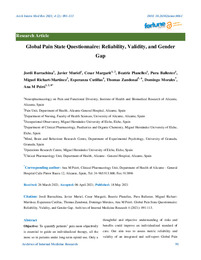Por favor, use este identificador para citar o enlazar este ítem:
https://hdl.handle.net/11000/32339Registro completo de metadatos
| Campo DC | Valor | Lengua/Idioma |
|---|---|---|
| dc.contributor.author | Barrachina, Jordi | - |
| dc.contributor.author | Muriel, Javier | - |
| dc.contributor.author | Margarit, César | - |
| dc.contributor.author | Planelles, Beatriz | - |
| dc.contributor.author | Ballester, Pura | - |
| dc.contributor.author | Miguel, Richart-Martínez | - |
| dc.contributor.author | Cutillas, Esperanza | - |
| dc.contributor.author | Zandonai, Thomas | - |
| dc.contributor.author | Peiró, Ana | - |
| dc.contributor.other | Departamentos de la UMH::Farmacología, Pediatría y Química Orgánica | es_ES |
| dc.date.accessioned | 2024-06-25T11:40:29Z | - |
| dc.date.available | 2024-06-25T11:40:29Z | - |
| dc.date.created | 2021-05 | - |
| dc.identifier.citation | Archives of Internal Medicine Research. 2021, 4(2): 91-113 | es_ES |
| dc.identifier.issn | 2688-5654 | - |
| dc.identifier.uri | https://hdl.handle.net/11000/32339 | - |
| dc.description.abstract | Objective: To quantify patients’ pain more objectively is essential to guide an individualized therapy, all the more so in patients under long-term opioid-use. Only a thoughtful and objective understanding of risks and benefits could improve an individualized standard of care. Our aim was to assess metric reliability and validity of an integrated and self-report Global Pain Status questionnaire to quantify the impact of pain on patient’s health in a more precise manner. Methods: A cross-sectional study was conducted to analyse the reliability, agreement, and validity of an integrated questionnaire compared to isolated scales, due to kappa statistics, intra- class and other correlation coefficients. Level of pain (intensity and relief), quality of life, most prevalent analgesic adverse events and hospital frequentation were registered in a total of 38 cases (pain unit patients) and 52 painless matched-controls.. A reduced multitrait-multimethod matrix and a canonical-correlation analysis were developed together with a multiple linear regression. Results: Cases (56 ± 10 years old, 63% females, pain intensity 66 ± 23 mm, incidence rate of 5 adverse events) represented a regular pain population. A high intraobserver correlation (r0.75- 0.88, weighted-κ 0.41–0.51, unweighted-κ 0.66-0.82) was evidenced together with significant correlation coefficients in test-retest reliability, and for validity, even more, in a reduced multitrait-multimethod matrix (>0.8) and canonical-correlation (>0.95). A gender gap was evidenced in cases’ companions, mostly middle-aged females (78%), who experienced negative effects on their health. Conclusions: The Global Pain Status questionnaire is an evaluation instrument with enough reliability and validity, being a low-cost method to determine the multidimensional pain management at clinical routine. A gender-gap within pain caregivers was found that affect their health outcomes. Support interventions for pain patients’ companions should consider specific gender risk factors. | es_ES |
| dc.format | application/pdf | es_ES |
| dc.format.extent | 23 | es_ES |
| dc.language.iso | eng | es_ES |
| dc.publisher | Fortune Journals | es_ES |
| dc.rights | info:eu-repo/semantics/openAccess | es_ES |
| dc.rights.uri | http://creativecommons.org/licenses/by-nc-nd/4.0/ | * |
| dc.subject | Reliabilit | es_ES |
| dc.subject | Validity | es_ES |
| dc.subject | Chronic Pain | es_ES |
| dc.subject | Gender | es_ES |
| dc.subject | Analgesic Response | es_ES |
| dc.subject.other | CDU::6 - Ciencias aplicadas::61 - Medicina::615 - Farmacología. Terapéutica. Toxicología. Radiología | es_ES |
| dc.title | Global Pain State Questionnaire: Reliability, Validity, and Gender Gap | es_ES |
| dc.type | info:eu-repo/semantics/article | es_ES |
| dc.relation.publisherversion | https://doi.org/10.26502/aimr.0061 | es_ES |

Ver/Abrir:
Global Pain State Questionnaire Reliability, Validity, and Gender.pdf
1,18 MB
Adobe PDF
Compartir:
 La licencia se describe como: Atribución-NonComercial-NoDerivada 4.0 Internacional.
La licencia se describe como: Atribución-NonComercial-NoDerivada 4.0 Internacional.
.png)